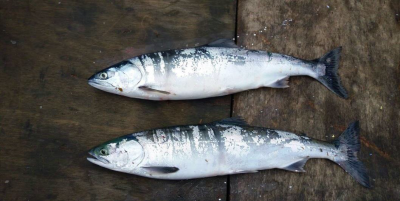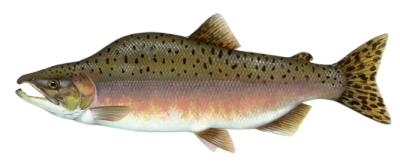The Environment Agency have published the briefing below regarding Atlantic Salmon. If you have any queries regarding Pacific pink salmon please contact the Environment Agency through the means provided at the end of the article.
Brief background
- Over recent weeks the Environment Agency has received an unusually high number of reports of Pacific pink salmon (Onchorhyncus gorbuscha) which have been captured in both rod and net fisheries in North East of England.
- To date, we believe that over 200 pink salmon have been captured in the North East coast salmon net fishery with an increasing number of reports from rod and line anglers within freshwater, particularly in Scotland and Ireland. There is a possibility that these fish might be present in other rivers throughout England and Wales following the recent capture of a pink salmon in County Cork, Ireland.
- Pink salmon are the smallest and most abundant of the five Pacific salmon species and are a non-native salmon species within the North Atlantic Area.
Where have Pacific Pink salmon come from?
- Pacific pink salmon are also known as humpback salmon and originate from the northern areas of the Pacific Ocean. Significant numbers of pink salmon have been stocked in the White Sea region of northern Russia and the Kola Peninsula from the 1950’s until 2003 to develop a commercial net fishery. The species has now established self-sustaining populations in a number of rivers in Russia, Finland and northern Norway. We believe that this is the most likely origin of the pink salmon recently caught in the UK and Ireland.
- Unlike Atlantic salmon, pink salmon have a two-year lifecycle and generally spawn during the late summer months in late August and early September. Spawning is reported to take place in the lower reaches of rivers systems with the eggs laid in river gravel. The eggs hatch in the late spring and the juveniles rapidly “smolt” and migrate to see without feeding in freshwater. They are therefore unlikely to compete with wild Atlantic salmon and sea trout.
- All adult pink salmon die after spawning. Due to their 2 – year lifecycle, the progeny will be derived from distinct ‘odd’ or ‘even’ years, with the Russian/Norwegian fish being odd-year stocks. It is therefore possible, and likely, that these fish will appear in numbers again in 2019 although there are also some even year stocks.
Key issues and risks
- Whilst we do not believe that Pink salmon are an immediate threat to wild Atlantic salmon in terms of competition for spawning sites and juvenile recruitment, there is a risk of this species introducing novel parasites or diseases to native wild salmonids. We are therefore seeking to obtain samples of pink salmon from rod and line anglers and netsmen. These are being sent to our national fisheries laboratory at Brampton who will be undertaking post mortems and a range of analytical procedures. In addition, our fish health staff at Brampton will also be liaising with other fish disease authorities in Scotland to ensure that samples are pooled and knowledge and resources are shared. The findings from these studies will be distributed in due course when complete.
- We have reviewed our national fisheries legislation and identified that pink salmon are covered under S41 of the Salmon and Freshwater Fisheries Act (1975). This means that an Environment Agency rod and net fishing licence is required to fish for this species with a need to make catch returns reporting their capture.
- We have also established that the National salmon byelaws which protect spring Atlantic salmon also cover Pink salmon. There is therefore a current requirement to return all salmon species before the 16th June in rod fisheries. We are currently attempting to establish if Pink salmon fall under the Wildlife and Countryside Act (1981) which would require the retention of any non-native invasive species. However, it is unclear if this legislation applies to species that arrive under their own migratory powers (similar to migrant bird species).
- We have established that the National migratory salmonid carcass tagging and prohibition of rod caught salmon byelaws introduced in 2009 apply specifically to Atlantic salmon and sea trout. Therefore, at the current time, we cannot enforce the need for captured pink salmon to be carcass tagged or recorded within netsmen log book. It is also currently legal for rod and line anglers to sell Pink salmon. To deal with this issue, in the North East we have advised netsmen that we do require pink salmon to be carcass tagged and to be recorded in log books. This will help us to evaluate the numbers of pink salmon captured and account for them within our assessment of wild atlantic salmon and sea trout exploitation.
- In the immediate future (2018), depending on the outcome of the five point approach salmon exploitation consultation, it is proposed that we include the need to carcass tag and report pink salmon in the log book as a net licence condition. We will then set about seeking a formal amendment to the current byelaws so that they include all salmon species by 2019. 2019 will potentially be the next year when a large abundance of pink salmon is likely to appear in catches in England.
- We have considered the ability to implement an emergency byelaw to cover the potential loophole in the carcass tagging and prohibition of rod caught salmon byelaws and we have been advised that our emergency byelaw making powers do not extend to this situation as there is no evidence of any fish species being in immediate risk of harm.
- The risk of anglers selling pink salmon is believed to be low as the number of pink salmon captured on rod and line is currently very small. However, there is a risk of native wild salmonids being misidentified and offered for sale as pink salmon (especially when fresh run from the sea) and we will need to be vigilant for this risk and act if necessary.
- We have informed Defra of this issue and they will be working with us over the next few months to ensure that our regulatory position in relation to pink salmon is secured.
What are we doing now?
- We have contacted all netsmen in the North East and asked them to report the capture of pink salmon and for these fish to be processed in to the normal way with carcass tags and reporting in log books. Angling clubs and associations have also been contacted in the North East.
- There is a recognition that we should also now widen the call for reports of pink Salmon to all rod and net fisheries fishing on principle salmon rivers in England. This reflects the later run timings on these rivers. It is possible that pink salmon will be associated with shoals of wild atlantic salmon and may follow them into estuaries and rivers further south.
- We have written the attached advisory note and would be grateful for your assistance in distributing this internally to wider network of colleagues and to your external network of fishery associations/ riparian owners/ netsmen/ rivers trusts and anyone else with a direct interest in migratory salmonid fisheries.
- We are asking for reports to be immediately reported to Jonathan Shelley who is co-ordinating reports from anglers and netsmen in the North East. Alternatively, anglers can also send samples directly to our Fisheries Laboratory at Brampton where Gareth Davies will be the lead contact.
- If you have any further queries please contact Jonathan Shelley on 07979 704 281 or by email [email protected].
- If you have obtained a whole pink salmon or scales from anglers or netsmen please arrange for these to be sent to Gareth Davies at Brampton Lab. Gareth can be contacted on [email protected] or by phone 0203 025 18 37
- The National Sea Trout and Salmon Group will be monitoring the situation and seeking to ensure that we effectively manage the impact and exploitation of pink salmon to ensure that it does not compromise the viability of Atlantic salmon stocks. If you wish to contact the NSTSG please direct correspondence to Lawrence Talks email [email protected]

